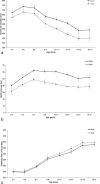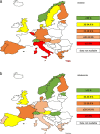Variations in accelerometry measured physical activity and sedentary time across Europe - harmonized analyses of 47,497 children and adolescents
- PMID: 32183834
- PMCID: PMC7079516
- DOI: 10.1186/s12966-020-00930-x
Variations in accelerometry measured physical activity and sedentary time across Europe - harmonized analyses of 47,497 children and adolescents
Abstract
Background: Levels of physical activity and variation in physical activity and sedentary time by place and person in European children and adolescents are largely unknown. The objective of the study was to assess the variations in objectively measured physical activity and sedentary time in children and adolescents across Europe.
Methods: Six databases were systematically searched to identify pan-European and national data sets on physical activity and sedentary time assessed by the same accelerometer in children (2 to 9.9 years) and adolescents (≥10 to 18 years). We harmonized individual-level data by reprocessing hip-worn raw accelerometer data files from 30 different studies conducted between 1997 and 2014, representing 47,497 individuals (2-18 years) from 18 different European countries.
Results: Overall, a maximum of 29% (95% CI: 25, 33) of children and 29% (95% CI: 25, 32) of adolescents were categorized as sufficiently physically active. We observed substantial country- and region-specific differences in physical activity and sedentary time, with lower physical activity levels and prevalence estimates in Southern European countries. Boys were more active and less sedentary in all age-categories. The onset of age-related lowering or leveling-off of physical activity and increase in sedentary time seems to become apparent at around 6 to 7 years of age.
Conclusions: Two third of European children and adolescents are not sufficiently active. Our findings suggest substantial gender-, country- and region-specific differences in physical activity. These results should encourage policymakers, governments, and local and national stakeholders to take action to facilitate an increase in the physical activity levels of young people across Europe.
Conflict of interest statement
The authors declare that they have no competing interests.
Figures



Comment in
-
Population-level physical activity surveillance in young people: are accelerometer-based measures ready for prime time?Int J Behav Nutr Phys Act. 2020 Mar 18;17(1):28. doi: 10.1186/s12966-020-00929-4. Int J Behav Nutr Phys Act. 2020. PMID: 32183807 Free PMC article. No abstract available.
References
-
- Poitras VJ, Gray CE, Borghese MM, Carson V, Chaput JP, Janssen I, Katzmarzyk PT, Pate RR, Connor Gorber S, Kho ME, et al. Systematic review of the relationships between objectively measured physical activity and health indicators in school-aged children and youth. Appl Physiol Nutr Metab. 2016;41(6 Suppl 3):S197–S239. - PubMed
-
- Cooper AR, Goodman A, Page AS, Sherar LB, Esliger DW, van Sluijs EM, Andersen LB, Anderssen S, Cardon G, Davey R, et al. Objectively measured physical activity and sedentary time in youth: the International children's accelerometry database (ICAD) Int J Behav Nutr Phys Act. 2015;12:113. - PMC - PubMed
-
- Van Hecke L, Loyen A, Verloigne M, van der Ploeg HP, Lakerveld J, Brug J, De Bourdeaudhuij I, Ekelund U, Donnelly A, Hendriksen I, et al. Variation in population levels of physical activity in European children and adolescents according to cross-European studies: a systematic literature review within DEDIPAC. Int J Behav Nutr Phys Act. 2016;13:70. - PMC - PubMed
Publication types
MeSH terms
Grants and funding
- G0501306/MRC_/Medical Research Council/United Kingdom
- MC_PC_19009/MRC_/Medical Research Council/United Kingdom
- G0701877/National Prevention Research Initiative/International
- MR/K023187/1/MRC_/Medical Research Council/United Kingdom
- BHF_/British Heart Foundation/United Kingdom
- MC_UU_12015/3/MRC_/Medical Research Council/United Kingdom
- MC_UU_00006/4/MRC_/Medical Research Council/United Kingdom
- MC_PC_15018/MRC_/Medical Research Council/United Kingdom
- MC_UU_12015/3; MC_UU_12015/7/MRC_/Medical Research Council/United Kingdom
- G0701877/MRC_/Medical Research Council/United Kingdom
- CSO_/Chief Scientist Office/United Kingdom
- CRUK_/Cancer Research UK/United Kingdom
- MC_UU_12015/7/MRC_/Medical Research Council/United Kingdom
- DH_/Department of Health/United Kingdom
- MR/K02325X/1/MRC_/Medical Research Council/United Kingdom
- MC_UU_00006/5/MRC_/Medical Research Council/United Kingdom
LinkOut - more resources
Full Text Sources
Medical

